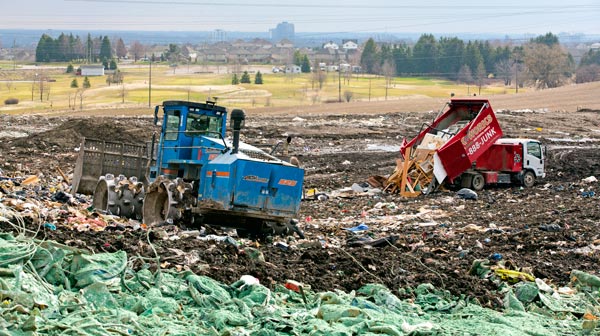In conjunction with Earth Day, Waterloo Region’s Erb Street landfill site will be open to free tours April 25, a chance for curious residents to see what happens to their waste and recyclables. How to manage our garbage is something of a hot topic in the region these days, as the landfill is expected to reach maximum capacity by 2030, and a waste management master plan is in the works.
![Residents can get up close and personal with the Waterloo landfill on Apr. 25 to see how their waste is compacted and recyclables are reused. The region is considering using thermal technologies to deal with the waste once the dump is full, and has proposed two different options for region-wide waste collection.[Tristan Urry / The Observer]](https://www.observerxtra.com/content/images/wp-content/uploads/2015/04/post_garbage1.jpg)
Council is considering two options for curbside collection, since the current contract expires in 2017 and it will take about 18 months to get trucks and staff in place, once a company’s awarded the contract. Cari Howard, project manager for waste management programs, says the changes will be universal across the region, instead of the varying bag limits imposed now.
“Some of the really rural areas in the township, people only have every two week blue box collection and they don’t have green bin collection yet,” Howard said. “We’re proposing no matter where you live in the region curbside garbage services will be the same.”
The first option is biweekly collection of four garbage bags, unlimited weekly green bin and blue bin pickup, continued biweekly yard waste pickup, and biweekly appliances and bulky item pickup with a three item limit. The second option is the same, except garbage will be picked up weekly with a two bag limit.
“Residents seem to be split about whether they prefer biweekly collection or not. We presented these proposed options to council but they haven’t been made to make a decision yet,” Howard said.
Waste management coordinator Shelley Conrad says the tour is a family friendly event and they’re encouraging families to come learn about where their waste goes and how they can make an impact by recycling. Highlights of the tour include the tipping point where waste that can’t be recycled is stored, and the recycling area where paper, plastic, and metal are sorted and reused.
![Employees for a private company sort the recyclables into three categories.[Tristan Urry / The Observer]](https://www.observerxtra.com/content/images/wp-content/uploads/2015/04/post_garbage2.jpg)
“They also get to see the diversion area, so we’ll talk about programs that we have on site, like Goodwill and Habitat for Humanity,” Conrad said.
The recyclables are brought into the facility and sorted into three different containers. From there they go through the baler and become compressed into large colorful cubes.
“It’ll be then put on a tractor trailer and taken away where processors will use them for raw materials,” Conrad said. “Our containers can become anything like plastic lumber, plastic #1, which is a water bottle or a pop bottle, or even fabric. Juice boxes can be made into paper products, so recycled content of paper towels.”
While recycling has certainly caught on in the region, due to the blue bin’s origins with Kitchener native Nyle Ludolph, the money-losing green bin remains a work in progress. Howard says there’s a 19 to 35 per cent usage rate depending on the neighbourhood. That’s an issue when up to 53 per cent of landfill garbage could have been composted.
“We can turn it into beneficial compost,” Howard said. “Farmers will spread it on their fields and grow more food.”
In terms of disposal, manager of engineering for waste management programs Donna Serrati says they’re looking at three options for what to do with the landfill once it’s full.
“We took a very high level look at three different paths,” Serrati said. “One being another landfill, and then the other is a combination of a mechanical biological treatment option, and the third was the thermal treatment pathway, which could include incineration. It could also include gasification, or other types of technologies.”
After considering environmental, financial and social impacts, along with public consultations, they’ve decided to look further into thermal treatment. Thermal technology offers some energy recovery potential she says, meaning it could potentially generate electricity or heat, or produce biofuel.
“It is on balance more expensive than the cheapest option, which would be another landfill,” Serrati said. “People recognize that landfilling comes with a big environmental footprint and a lot of other potential negative social and environmental implications. We’re looking at the feasibility of the region pursuing some sort of thermal treatment disposal option.”
Where the treatment would happen is unclear. It could be inside of the region, outside the region, with a municipality partner or a third party private partner, she noted. If council decides to go this route and do the treatment inside the region, an environmental assessment would be required.
As for what would happen to the landfill it would be permanently sealed.
“Any environmental control structure that needs to remain in place to deal with gas that continues to be generated remains operational,” Serrati said. “The terminology that’s used is passive recreation. It’s basically naturalized. It becomes a field with a bit of a hill.”
She noted a major goal of the master plan is to maximize the diversion of garbage so a minimum amount will need to be treated instead of recycled.
“People have the opportunity to make a difference in that regard in part by using the green bin,” Serrati said. “That keeps a lot of material out of the landfill and it gets out of that disposal pathway and into more of a beneficial reuse path.”
Residents who wish to give their opinions on the curbside collection can do so May 6 at 6 p.m. at the Planning & Works Committee public input meeting.
To reserve your seat on the bus for the landfill tour call 519-575-4400 and meet at Gate 3 of the landfill. Tours will run every half hour from 9 a.m. to 12 p.m. and then on the hour until 2 p.m. Conrad says usually 300 to 500 people take the tour each year.
“It’s a good opportunity for people to come and find out how it operates, where their waste goes, because you put your stuff out on the street and it goes away,” Conrad said. “You’re not home, you don’t see it, you don’t know really what happens to it. So when people come here and they see the facility they’re impressed by how much we can recycle and why we should reduce our waste because the landfill is filling up.”








